

 |
||||||||||||||||||||
|
||||||||||||||||||||
Discovery Gator Binoculars by Levenhuk
Produced by Levenhuk, but endorsed by the Discovery Channel, the Gator series consists of nine different models (at the time of writing), all of which are relatively low costing instruments. Currently there are four compact roof prism models, a reverse porro prism compact (see my Discovery Gator 8-20x25 Binoculars Review) and four classically shaped porro prism instruments which include this 10x50 model, as well as a 20x50, a 8x40 and the 10-30x50 Discovery Zoom Binoculars.
Specs & Features at a Glance:
Shape
These 10x50 Discovery Gator binoculars sport the classic, iconic shape for a binocular, which is primarily down to them using a porro prisms inside to correct the inverted image. This shape also often makes for a very comfortable and well balanced instrument to hold onto and the good news is I found this to be exactly the case with these. The trade off being that this design is less streamlined and therefore less compact than most 50mm roof prism binos.
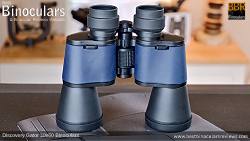 Chassis
Chassis
No mention of the materials that are used for the housing by the manufacturers, but from what I can see, it looks like a combination of aluminium and polycarbonate plastic.
Exterior Rubber Coating
Apart from the rear and front face plates and the bridges most of the main chassis and the barrels is covered in a rubber coating. As it is quite thin, it does not help much in terms of impact protection. It is also quite a hard rubber, which only slightly improves the grip level, but at the same time, I find rubber coatings like this tend to be longer lasting and less likely to perish than the softer coatings that are sometimes used.
Not Fully Waterproof
Note that these are described as water-resistant binoculars and thus are not completely 100% water proof.
The lack of airtight seals also means that they will not contain a dry nitrogen or argon gas interior and thus the internal optics are not protected from fogging up.
Inter-Pupillary Distance (IPD) Adjustment
Opening and closing the central hinge adjusts the distance between the eyecups. It is in this way that you can set up the bin to match the distance between your eyes.
With a minimum setting of 5.6cm and a maximum of 7.2cm, this Discover Gator binocular has an fairly typical IPD (Inter-Pupillary Distance) range for a full sized instrument and so should be fine for most adults and teenagers.
Tripod Adaptable
As should always be the case on a bino of this size, you can easily fix them to a tripod using almost any normal/standard tripod adapter by simply removing the dust cap on the front hinge and then screwing in the adapter.
Not only does this ensure a completely steady view, but this can be very useful in situations like at a hide when you want to keep your optics trained on a specific area over longer periods.
These Discovery Gator 10x50 binoculars have a fairly typical centrally located focus wheel that is nice and large, is rubber coated and protrudes well up above the body to make reaching and tuning it straightforward, even whilst wearing gloves.
It takes about one full turn of the wheel to go from the minimum close focus to it's maximum, which is less than most, but more than some, meaning that I feel you get a good balance between the speed of making large focal adjustments versus these ease of fine tuning the focus to get it pin sharp.
The mechanism on my sample was nice and smooth without any stiff sections or sticking points, nor was it too loose meaning that making focal adjust mens was nice and easy, but at the same time remained at your desired setting.
The Eye Cups
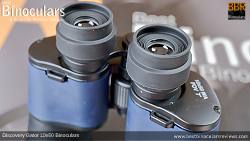 These Discovery 10x50 Gator binoculars come with very simple fold up/down eyecups made from rubber.
These Discovery 10x50 Gator binoculars come with very simple fold up/down eyecups made from rubber.
Eyecups that can be twisted up and down are usually superior to these as this makes them far more adjustable as well as potentially longer lasting because these can sometimes perish along the fold line.
Having said that, as far as this type of eyecup goes, these are not bad as I found them to be comfortable and they look to be made from a tough rubber should not perish quite as easily as that on some I have come across.
Diopter Adjustment 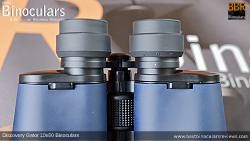 Dioptric corrections are made by turning the right eyecup, which independently changes the focus on this side from the other. This is an important step and something you should do when calibrating your binoculars to accommodate your particular vision.
Dioptric corrections are made by turning the right eyecup, which independently changes the focus on this side from the other. This is an important step and something you should do when calibrating your binoculars to accommodate your particular vision.
Most binoculars have a diopter ring positioned just under the right eyepiece, whereas the system on these means you turn the whole eyepiece.
Unless you share your bins, diopter adjustments in theory only need to be carried out once and so the diopters that function as a separate ring under the eyecup that can be locked or at least not easily turned by accident are in my opinion superior. So it is for this reason if your particular setting is not neutral, I would strongly suggest that you make a mark with a pen or etch it with a knife so that it makes it easier to return it to your setting without the need of re-calibration.
Body Quality Score: 6/10
Size
In terms of their dimensions, these are fairly typical for a 50mm porro prism bin and so not too much to mention here, but are fair bit larger (especially wider) wider than your standard 42mm roof prism binocular.
Weight
Levenhuk does not mention the weight of these in their specifications.
My scale pegged them at 762 grams (without lens covers or neck strap), which is less than most other similar sized instruments. Important to keep in mind that this will probably be partly down to them using a little more plastic parts (like the face plates) than the metal ones used on higher end products.
Body Stats Score (vs other full sized Bins): 7/10
50mm Objective Lenses
By using slightly larger diameter 50mm objective lenses with a 10x magnification, there is the potential for binoculars like these to compete in terms of image brightness and low light performance with an 8x42 binocular, but at the same time they will also offer more image detail at distance.
This is because larger objective lenses can capture more light, and on top of this, the 10x50 configuration results in a larger exit pupil size being produced:
10x50's will usually deliver a 5mm (50 ÷ 10 = 5) tube of light exiting the eyepiece. If we compare this to an 8x42 binocular with it's 5.25mm exit pupil (42 ÷ 8 = 5.25), you can see that both will supply your eyes with a similar amount of light. Whilst a 10x42, has a smaller 4.2mm exit pupil.
Obviously many other factors like the quality of the glass and the coatings also play a part, but with this set-up the potential for a bright image is there. For more on why, be sure to check out my complete guide to the exit pupil.
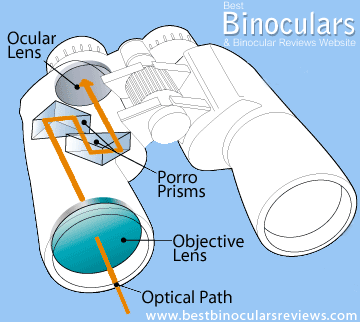 Prisms
Prisms
The shape of this instrument and the reason the eye pieces are not in line with the objective lenses the result of them using what are known as porro prisms to correct the image, which is perfectly demonstrated in the image on the right.
Levenhuk has used BK-7 glass as the prism material on these Discovery binoculars.
At this price point, BK-7 prisms are quite common, but due to them having a lower refractive index, they have a lower transmittance level and thus the image tends to be less bright and not quite as sharp around the edges as those that are made from BaK-4 glass which is generally the preferred option with binoculars.
One of the advantages of using porro prisms is that they do not require specialized coatings on them to achieve the same quality and brightness as that of roof prism made from an equal quality glass.
This generally makes this type of instrument easier and cheaper to make as the only other coatings required are the anti-reflection coatings that increase transmittance levels on the glass surfaces to which they are applied.
It is for this reason, at the lower price points like this, a porro prism bino is often a better choice.
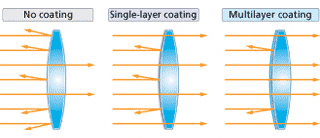 Anti-Reflection Coatings
Anti-Reflection Coatings
By improving the level of light transmittance and reducing unwanted reflections that can cause negative effects like ghosting, the level of Anti-Reflection Lens Coatings is one of the most important things to look for when buying binoculars.
Depending on the quality of coatings used and how many layers are used on which optical components this can make a noticeable difference to image quality and brightness.
This Discovery Gator 10x50 binocular is described as being Fully-Coated, which means that they have a single layer coating on all surfaces. This is not as desirable as a fully multi-coated instrument that will have multiple layer coatings on all surfaces, but it is better than Coated bins that only have a single anti-reflection coating added to the exterior lens surfaces.
Optical Components Score: 6/10
Field Of View (FOV)
At 115m @ 1000 meters / 345ft @ 1000 yards) the FOV on these is excellent for a 10x binocular. A wide FOV can be important in situations like trying to quickly locate and then follow fast moving birds at closer ranges for example.
| FOV at 1000yds | Near Focus | Eye-Relief | |
| Discovery Gator 10x50 | 345ft | 16ft | 12mm |
| Levenhuk Atom 10x50 | 345ft | 16ft | 12mm |
| Celestron LandScout 10x50 | 346ft | 22.9ft | 17.9mm |
| Atlas Optics Eagle Owl 10x50 | 342ft | 16.4ft | 19mm |
| Vortex Hurricane 10x50 | 341ft | 30ft | 15mm |
| 10x50mm Roof Prism | |||
| Kite 10x50 Lynx HD+ | 360ft | 8.5ft | 17.8mm |
| Swarovski 10x50 EL | 345ft | 9.2ft | 20mm |
| GPO 10x50 Passion HD | 309ft | 9.2ft | 17mm |
| Eschenbach 10x50 Arena D+ | 282ft | 10ft | 12mm |
Close Focus Distance
The minimum focus distance on these is advertised at 16ft (4.9 meters), which is ok, but not excellent.
As you can see in the table above, for a porro prism like these this is quite typical, but compared to many roof prism equivalents, it is quite long. For this reason, I would suggest that if you often view objects like butterflies from very close range, these would not make the ideal choice. If this is an interest of yours, be sure to check out my section on close focusing binoculars.
Eye-Relief:
Much like the close focus distance, the 12mm eye-relief is ok, but not excellent.
On top of this, a the simple fold-down eyecups are not really adjustable, there is not a lot you can do other than fold them completely down or use them at the maximum setting (unfolded).
For normal use and without wearing glasses, this is fine, but when I tested them with my glasses it did look like I was looking down tube, even with the eye-cups fully folded down and thus I would not recommend these should you need to wear your glasses when using your binoculars.
Optical Stats Score compared to other 10x Binoculars: 7/10
Image Brightness & Low Light Performance
With larger 50mm objective lenses that deliver a large 5mm exit-pupil with it's 10x power, I expect most 10x50 binoculars to offer up a nice bright image and perform reasonably well in low light.
However, at this price point and therefore using cheaper glass and fewer anti-reflection coatings than that on higher specification instruments, I was not sure just how well this particular 10x50 was going to perform.
Compared to my much higher quality 10x42's that I use as a benchmark for all reviews of full sized 10x bins, these did seem to me to be pretty much equal during the day in good light conditions.
Then comparing them again later on in the day/early evening in fairly poor light there was not a massive difference in the brightness, but I did notice that the colors were perhaps not as vibrant as that of my 10x42 benchmarks. So whilst thee are unable to match higher end instruments, I would still say that the image is fairly bright for a 10x binocular and certainly good compared to a 10x42 binocular at this price level.
Colors & Contrast
Whilst not quite as vivid as my mid-level benchmark, I thought that color reproduction was pretty good on these, especially considering the price range. By this I mean the image looks perfectly normal and without any obvious artificial tinting or hues that you can often find on cheap binoculars that use lower quality glass.
Likewise I though that the contrast between light and dark areas to be good for a low cost binocular, but not as obvious as that which you are presented with on higher end instruments.
Color Fringing
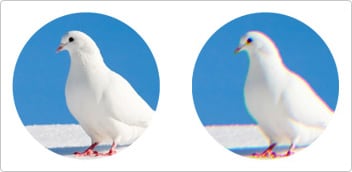 In terms of the level of color fringing that is evident around the edges of objects that contrast with the back ground, I though that these Discovery Gator binoculars performed very well and is certainly better than what I would expect to see through a 10x binocular that this or indeed the price range above them.
In terms of the level of color fringing that is evident around the edges of objects that contrast with the back ground, I though that these Discovery Gator binoculars performed very well and is certainly better than what I would expect to see through a 10x binocular that this or indeed the price range above them.
Image Flatness, Distortions & Blurring
The image produced to me looked nice and flat without any obvious errors that can sometimes make it look like the view is either curving inwards or outwards.
The small level of softening right at the edges of the view is also more than acceptable and better than many/most at this price range.
Image Quality Rating: 7/10
My sample Discovery Gator 10x50 binoculars came equipped with a soft carry case, neck strap, 4x lens covers and cleaning cloth:
Carry Bag
The included carry case is what I would describe as being very basic, but having said that, it is not poorly made as the materials look decent enough as does the stitching.
However, the amount of padding is very minimal and thus it does not provide any impact protection worth speaking of, but it will protect the bino from scratching, light rain and free from dust.
The size of the bag is good, but perhaps on the tight side for these Discovery 10x50 binoculars, so by this I mean they were easy to remove, but a little more tricky to replace.
The bag has a simple flap over lid with the Discovery logo on it. It is held close with a strip of Velcro and whist this works to a point, it is a less secure closure than a Zip for example and unless you are very careful, it can make enough noise when opening it to startle nearby birds etc. On the plus side, Velcro makes it very quick to open the bag to access the binos inside.
The bag has its own shoulder strap that can be adjusted for length. Made from threaded nylon, it is completely un-padded.
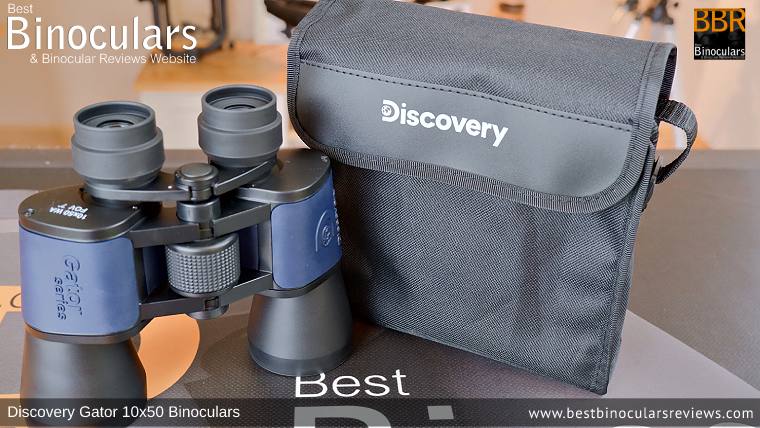
Neck Strap
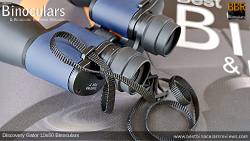 The included strap is not great and I have to say is about as basic as it gets as it consists of just a simple nylon cord that you thread through the eyelets on the sides of the binocular and then back on itself through a couple of sliders.
The included strap is not great and I have to say is about as basic as it gets as it consists of just a simple nylon cord that you thread through the eyelets on the sides of the binocular and then back on itself through a couple of sliders.
For a full sized 10x50 binocular, to me this is not really acceptable as having the binocular hanging around your neck from this all day when out in the field will become uncomfortable.
Lens Covers
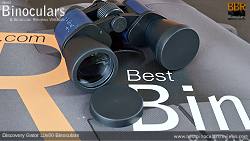 Both the objective and ocular lens covers come in the form of simple plastic cups that fit over the barrels/eye-cups.
Both the objective and ocular lens covers come in the form of simple plastic cups that fit over the barrels/eye-cups.
These all have a reasonably good fit and thus wont fall off to easily, yet at the same time are easy to take off and replace. They also do a good job of protecting and keeping the lenses clean when attached.
Having said this, I also feel it is a shame that they are not or cannot be tethered to the bin as you have to find a safe place to put them every time you use the bino. A good place to do this is the carry bag, but you do have to be strict with yourself otherwise if you are anything like me, there is a big risk of leaving them behind somewhere!
Cleaning Cloth
A cleaning cloth is included and whist it is not a very high end microfiber one, it is fine for cleaning the body and if you are very, very careful, to lightly dust off the lenses. However you will still be best off with a lens cleaning kit for safely cleaning the lenses.
Instructions & Guarantee
Also included within the box is some basic, generic instructions that covers the entire Discovery Gator series. You will also find the international warranty card that covers these binoculars for 2 years and entitles you to free repair or replacement in any country where a Levenhuk office is located.
Accessories Score (for a Compact Binocular): 4/10
Overall I would say that these Discovery Gator 10x50 binoculars are better than the majority of binos at this price level and so from that point of view, I think you are getting some good value for money. However, you should also keep in mind that there are also a number of areas where these do fall short and as good as they are at this level, they obviously can't compare to high-end instruments.
Strong Points:
Weaknesses:
At this very low price point, there are always going to be areas where the manufacturers have had to make tough decisions to keep the cost down and so whilst I could list the many areas where theses Discovery Gator 10x50 binoculars don't compare to higher end and more expensive equivalents, if they were to improve them in these areas, then these too would also have to cost more. So below are their weaker points that in my opinion fall short of what I would expect to see in this class:
Reviewed by Jason Whitehead for Best Binocular Reviews
|
Main Specifications & Features:

Below are similar pairs of Binoculars that you may also want to have a look at:
Cheap 50mm poro prism binoculars offer a good low light performance and very wide field of view
General Price Range: (2/6) Low Cost Binoculars
Below is a link that will take you to a page with online retailers in both the US and UK that sell Levenhuk 10x50 Discovery Gator Binoculars this page makes it easy to compare prices and then to buy from your preferred option:
|
Buy & Compare Prices for the Levenhuk 10x50 Discovery Gator Binoculars |
||
US Shoppers |
Canadian Shoppers |
UK Shoppers |
Deutsch Shoppers |
Aussie Shoppers |
Indian Shoppers |